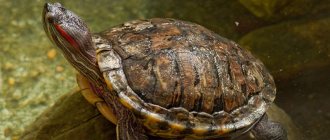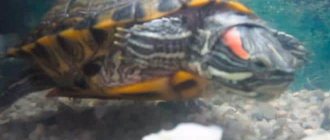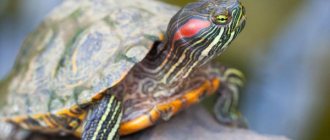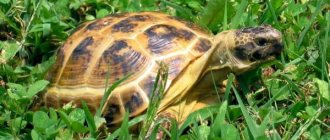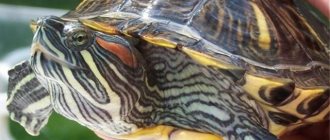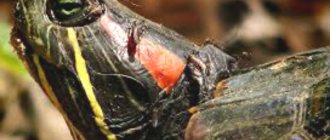The red-eared slider (lat. Trachemys scripta) is the most common among pet turtle lovers. Unfortunately, such popularity also has a downside: a huge number of domestic red-eared turtles are doomed to death or life in unsuitable conditions. Unscrupulous sellers often do not know or hide details from buyers in order to make money. To make this happen less often, we will tell you in detail about the maintenance, feeding and care of this turtle.
Description of the red-eared turtle
The yellow-bellied turtle received this name due to the presence of red stripes running from the eyes to the ears. Because of this unique feature, the red-eared turtle can be easily distinguished from other species of turtles kept in human environments.
Interesting to know! In conditions favorable for their habitat, red-eared turtles can live for at least 25 years. At the same time, there are individuals that live up to 50 years.
In young individuals, the shell is bright green, but as the turtle grows and develops, this shade becomes brown. In adults, original patterns can be seen on the shell, and each turtle may have a unique pattern. The size of a turtle directly depends on its gender and can range from 18 to 30 cm. Oddly enough, females are larger than males.
Sense organs
This animal is distinguished by a high level of development of sensory organs. The main features are as follows:
- Vision. Red-eared turtles distinguish colors, choose the most suitable places to lay eggs, and look for other turtles. They also see moving objects, the distance to which can reach 40 m, well distinguishing predators and prey from each other.
- Smell. These reptiles search for food thanks to their developed sense of smell.
- Hearing. These animals hear poorly. This is due to the fact that their ears are hidden under the skin. Therefore, red-eared turtles react only to vibration.
- Touch. The turtle's shell is equipped with nerve endings, so it feels touch. The presence of taste buds allows these creatures to choose tastier foods.
- Voice. The vocal apparatus of turtles is not developed; they are only capable of snorting and hissing. Sometimes they make a squeak.
Recommendations for purchasing a red-eared slider
Spring is the most suitable period for purchasing a pet. In warm weather, it is much easier for an animal to adapt to new living conditions, especially since in warm weather there is much more natural food. If you purchase a turtle in the fall, then in such conditions the turtle’s growth slows down and it is more difficult for it to adapt to new conditions. In addition, during this period there is a risk of developing rickets or pneumonia due to vitamin deficiency.
First of all, you need to carefully examine the shell. It must have the correct shape and be free from scratches, deformations and other damage. At the same time, it must be hard, which will indicate proper nutrition of the animal and its proper development. The leather should also not have cracks or any stains. If an animal has sunken eyes surrounded by a small “recess,” this means that the animal is sick and suffers from dehydration. The turtle's eyes should not be swollen, much less discharge. Her mouth should also be healthy, without white coating, abrasions or wounds. In this case, you should pay attention to the behavior of the little turtle. If the animal is lethargic, then something is wrong with it.
Interesting fact! A strange formation can be seen on the plastron of a young turtle. In fact, these are the remains of the gall sac, which supplies nutrients to the small creature. This alarming formation soon resolves on its own. After this, the animal begins to feed on its own and is quite active.
It is very important to learn how to determine the sex of red-eared turtles yourself, while small individuals look exactly the same, regardless of gender. As they grow older, sexual characteristics begin to fully appear. Males mature somewhat faster than females and are ready to mate when the carapace diameter is 10-12 cm, but females are still large. Males have much longer claws located on their front paws and they also have a thicker and longer tail. The male's cloaca is located almost in the center of the tail.
Care and maintenance of red-eared turtles!
Features of aquarium (aquaterrarium) arrangement
A container for keeping red-eared turtles is more accurately called an aquaterrarium, and a number of requirements are imposed on such a container. A turtle is a freshwater animal, so there must be a sufficient amount of water in the aquaterrarium. The water should be clean and warm, with a temperature of 22 to 28 degrees. The volume of the turtle house is at least 200 liters.
It is imperative to purchase a special water heater, an ultraviolet lamp, a thermometer, a heating lamp, a filtration system and a lighting system. In the aquaterrarium, a small island should be provided that smoothly turns into water. The area of this island is at least ¼ of the total area of the turtle’s home. The island is not formed on the basis of soil or gravel.
A home for a red-eared turtle is an environmentally friendly space that does not have toxic components and is absolutely safe for animals without the presence of sharp objects.
Interesting Facts
- Red-eared turtles are fast, powerful and very aggressive animals.
- In the wild, it is not difficult for them to attack other turtles and other animals available to them.
- Even among themselves, they often start fights, especially when it comes to food. They put many related species at risk of extinction. Therefore, in some countries, for example, in Australia, they are mercilessly destroyed. Although, apparently, this is not quite the correct approach to solving this issue.
Turtle diet
When kept at home, the red-eared turtle should receive low-fat, preferably river fish. Turtles should be given raw beef liver once for a couple of weeks. In addition, snails, crickets, feed cockroaches, earthworms, and also small aquarium fish should be included in the diet. Food items of plant origin should consist of aquarium vegetation, lettuce, dandelion leaves and plantain.
Interesting to know! Red-eared turtles feed in a peculiar way. They do not secrete saliva, so they only chew food under water.
The aquaterrarium must contain Vitakraft Sepia mineral stone. Many owners of such animals practice feeding their pets with factory diets, such as Tetra ReptoMin, Sera and JBL. The most preferred food that should be given to turtles at least once a month is carrots. Until they reach the age of one year, reptiles are fed every day, and then no more than once every two or three days.
Feeding red-eared turtles! 10 answers to the most popular questions
Additional heating
In the wild, the red-eared turtle loves to bask in the sun . Instead, a simple incandescent lamp and an ultraviolet lamp should be hung above the “island”. The latter is needed to ensure the normal development and growth of the red-eared turtle, as well as to prevent various diseases. The ultraviolet lamp should be located 50 cm above the “island”. It should first be turned on for 5 minutes 1-2 times a week, gradually increasing the duration to 30 minutes and the frequency to every day. It is advisable to install a thermometer to control the air temperature (it should not be more than 30 degrees).
Caring for a red-eared slider
Although turtles are easy-to-keep animals, they still require specific care. The presence of clean water is a guarantee of the health of growing young animals and a guarantee of their active growth. Food that gets into the water begins to decompose and the water takes on a dirty, cloudy appearance, indicating that it is time to change the water. To fill the aquaterrarium, it is necessary to use water that settles for a week (at least 5 days). It is very important to maintain optimal temperature conditions. To do this, you can use a regular incandescent lamp aimed at the island. If necessary, the water is heated by a special heater. Here, a lot depends on the temperature in a person’s home.
It is important to know! Many people believe that if pets are kept in cramped conditions, they do not grow and always remain the same small. Unfortunately, this is a misconception that can lead to the death of the turtle.
Some time passes and the turtle begins to eat on land, which simplifies this process and also reduces the degree of water pollution. It is desirable that the island for resting and eating has not a simple, but a rough surface, then the turtle will be able to get to land without much effort. Individuals that differ noticeably in size should not be kept within the same aquaterrarium.
Many people think that red-eared turtles are slow and clumsy. In fact, they are capable of showing miracles of activity, both in water and on land. Therefore, it is very important that the height of the walls of their home does not allow them to get out. As a rule, the minimum height of the walls should be within 40 cm and not lower. If a turtle accidentally leaves the aquaterrarium, it can receive very serious injuries by falling from a height. As a result, the pet may die, not only from injury, but also from dehydration.
Hibernation
Hibernation is the period that a turtle enters during the winter months. There is no need for a pet turtle to hibernate! Moreover, it is not recommended! Never encourage her to do this.
Reasons why hibernation may be unsafe:
- you may not have enough experience to care for her at this time
- Most likely, in order for her to hibernate normally, you don’t have the conditions
- young and sick turtles may be too weak to survive the hibernation period
- your turtle may not need it at all
Turtles hibernating in nature burrow into leaves and silt at the bottom of a reservoir, the depth of which is shallow, and vice versa into the surface.
They do not rise to the surface during this time, but absorb oxygen through membranes in the mouth, pharynx and cloaca. In this case, the depth of the reservoir is important so that the water is not too cold, but also contains enough oxygen.
Most artificial conditions and ponds are unable to recreate these conditions.
In general, a pet turtle should not and should not be hibernated. By the way, the key condition here is the water temperature, it must be maintained at 24-26°C. Lower temperatures just remind her of winter and hibernation.
Health, disease and prevention
As a rule, most pets, including the red-eared turtle, get sick in most cases due to improper care and maintenance. Dirty and untreated water quickly leads to the fact that the turtle begins to feel unwell, as many harmful microorganisms appear in it. In this case, it is necessary to raise the temperature in her home by a couple of degrees in order to optimize the functioning of the immune system. It is also necessary to ensure that the animal does not experience a lack of moisture (water), otherwise, against this background, kidney failure begins to develop, leading to disastrous consequences.
The fact that something is wrong with the turtle may be indicated by its behavior. When it swims, it can fall on its side or even sink to the bottom. If there is a suspicion of infection, then it is advisable to treat all items for caring for the reptile with an antiseptic that will not cause harm to the animal. Symptoms of bacterial damage are associated with the appearance of edema and necrotic changes. Such diseases require the use of antibiotics for treatment. In this case, you will have to completely replace the water in the aquaterrarium.
If a turtle is injured, an infection can enter its body, leading to blood poisoning. As a result, the animal’s paws turn red, and the turtle becomes quite lethargic and inactive. This type of disease is practically not curable, especially on its own, so you will have to visit qualified specialists. If treatment for your pet is not started in a timely manner, the outcome can be very disastrous.
To prevent this from happening, it is necessary to take preventive measures, such as:
- Inspect your turtle daily.
- Clean the aquaterrarium regularly.
- Change the water regularly.
- Organize proper healthy nutrition.
- Avoid hypothermia.
- Monitor the operation of the heating, lighting and filtration systems.
- Observe personal hygiene rules.
- From time to time, clean the turtle's shell of algae.
- Adhere to the rules for keeping sick or newly purchased animals (quarantine regime).
- Avoid contact of a sick animal with both family members and pets.
- Constantly monitor the turtle's movements outside its home.
- Periodically turn on the UV lamp and expose it to sunlight.
- From time to time, show the animal to a veterinarian.
In case of improper nutrition, the turtle begins to experience a lack of calcium, which leads to curvature and softening of the shell. If there is too much calcium deficiency, your pet may die. In such cases, the veterinarian prescribes drugs with a high calcium content in injections. It is also necessary to know that calcium is absorbed due to the presence of vitamin D in the animal’s body. Vitamin D is produced as a result of UV exposure, so it is very important to regularly turn on the UV lamp.
Pond slider. House maintenance. Interesting Facts.
Handling babies
When a small turtle appears in an aquarium, it should be surrounded with maximum care and attention. If you don't pay attention to a delicate creature, it can die . There are several recommendations on how to care for a small red-eared turtle:
- It is not recommended to pick up babies. Stressful situations for them can result in illness and death.
- Do not stand over the aquarium or knock on its glass.
- The aquarium should not be left in direct sunlight or in a draft.
- The water temperature for babies should be 26-27 °C, the air temperature - 32 °C.
- The water needs to be changed every two days.
- It is necessary to saturate the turtle’s body with calcium.
- Children and adults cannot be kept together.
It must be remembered that many possible health problems in red-eared sliders can be avoided. If you follow the recommendations, this beautiful creature will delight its owner for decades .
Reproduction at home
When turtles live in their natural environment, they begin to reproduce only after reaching 6-8 years of age. When turtles are kept in an artificial environment, they are ready to reproduce at a maximum of 5 years of age. Under natural conditions, the reproduction process begins at the end of February and lasts until May. Having met a female, the male tries to position himself as close to the female’s head as possible.
Important point! At this time, the female moves forward, and the male moves in the opposite direction, while he tries to tickle the female’s chin with his long claws.
When the time comes to lay eggs, the female leaves the pond and heads to land, where she begins to search for a suitable place. After this, she wets the soil with water, which she prudently stored in the anal bladders. Then the female begins to form a nest.
To do this, she uses her hind legs. As a result of the active actions of the turtle, a ball-shaped nest is formed, the diameter of which, depending on the type of turtle, can reach up to 7-25 cm.
The female lays from five to twenty eggs at a time, the diameter of which is up to 4 cm on average. After this process, the turtle covers them with soil. Turtles do not care about their future offspring and immediately climb back into the sea (into the water). Eggs develop at temperatures from +21 to +30 degrees for 3-5 months. When the development of eggs occurs at a temperature of +27 degrees and below, then males are born, and when at a temperature of about +30 degrees and above, females are born.
A crowd of red-eared turtles!
Habitat
Red-eared turtles are found in the area from southern Virginia to northern Florida and Kansas, Oklahoma and New Mexico in the west (USA), Mexico, all of Central America, northwestern South America (northern Colombia and Venezuela). The species is introduced to the south of Florida, Arizona, Guadeloupe, Israel and South Africa and a number of other countries. Turtles live in small lakes and ponds with low, swampy shores.
